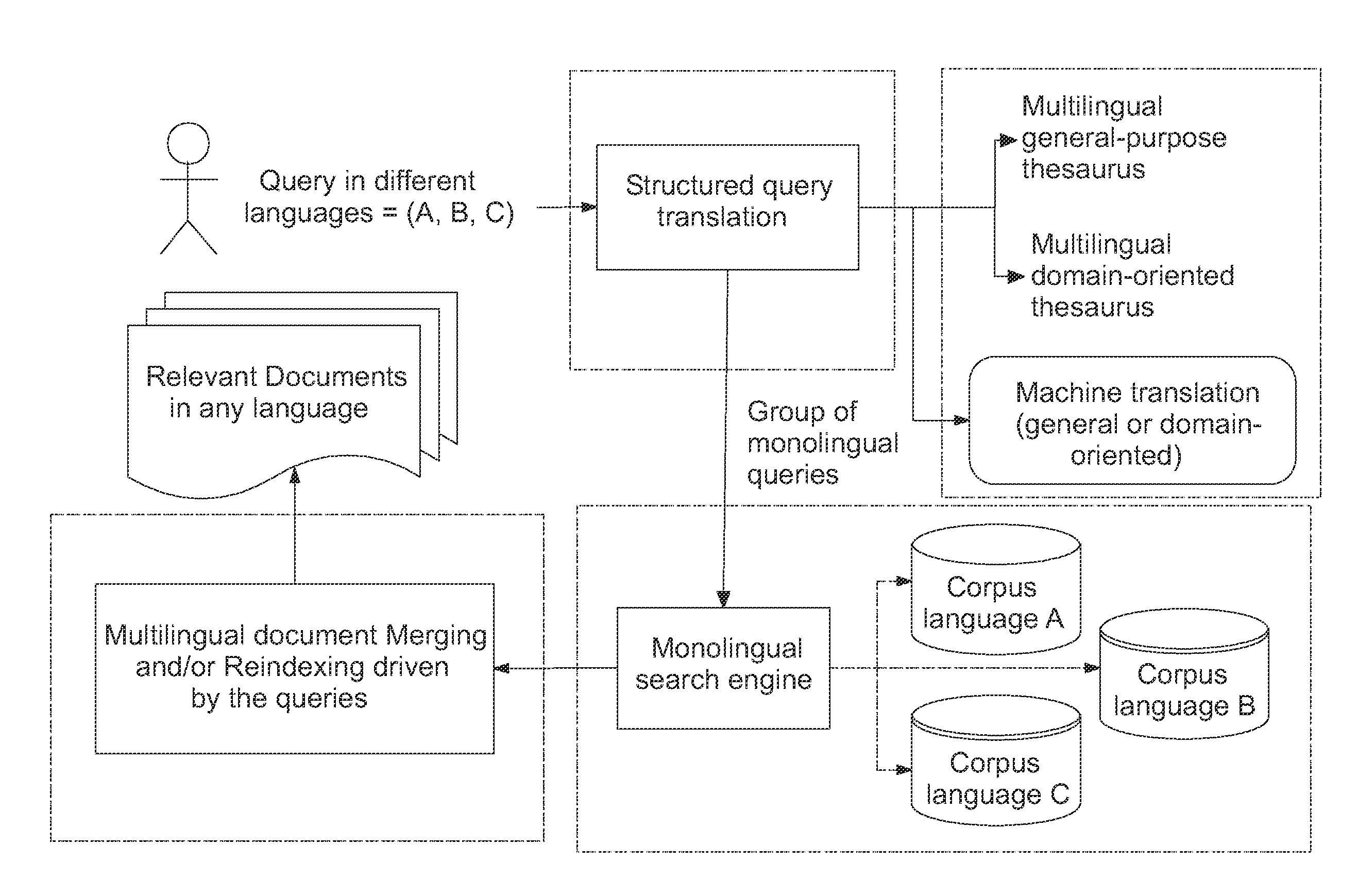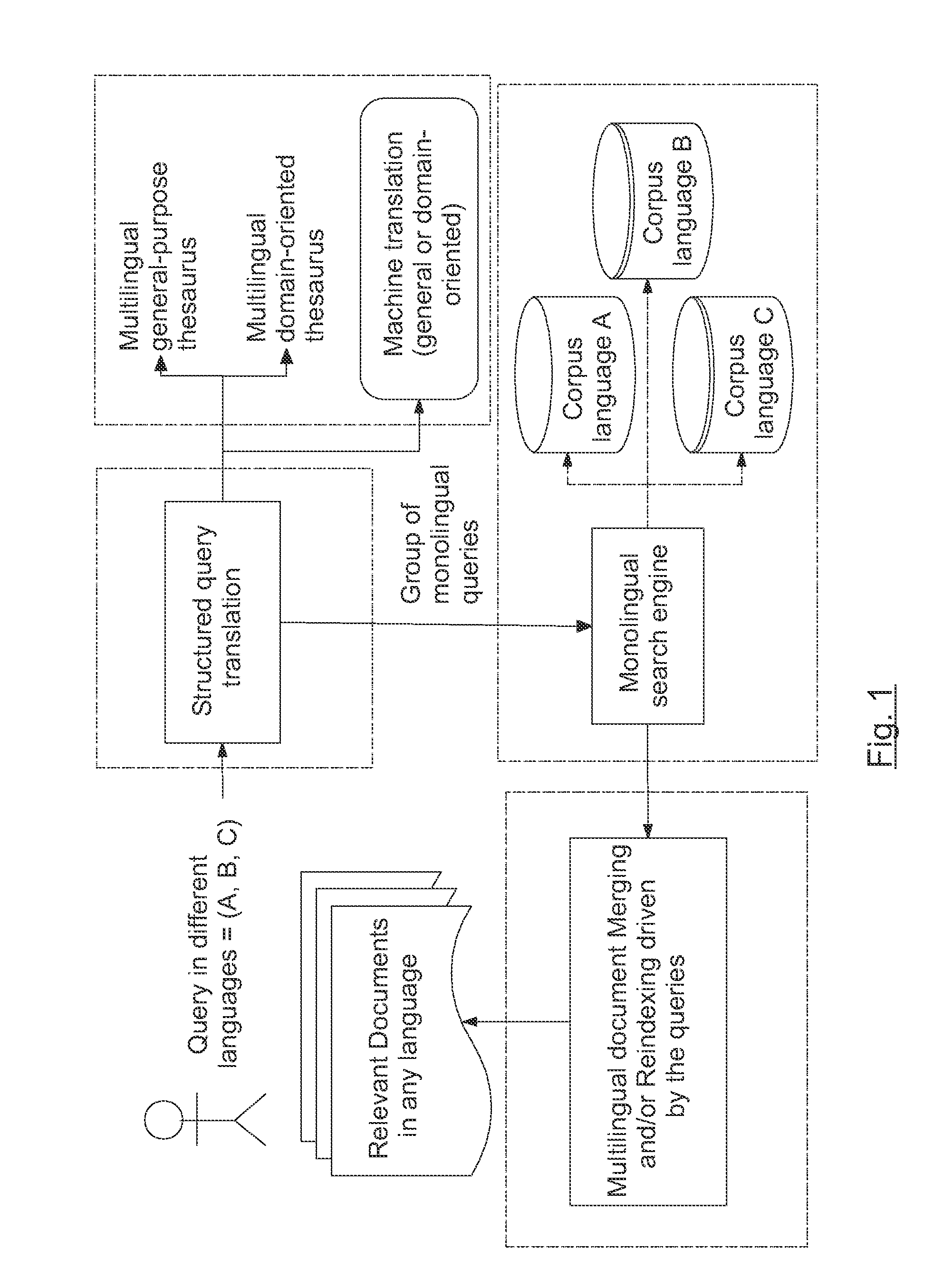The main limitation of the VSM model is its lack of meaning.
3], most of the current academic
information retrieval models use a standard “bag of words” VSM model with meaningless terms, which make impossible to retrieve documents using queries with non-explicitly terms mentioned in the corpus.
By other hand, the same situation occurs in other related problems where the same meaningless version of the VSM model was used, by example, in the
text categorization problem [Sebastiani, 2002] [Lewis et al., 2004].
As it is noted in [Metzler, 2007], little information is known about the IR models used in commercial search engines like Yahoo, or Google, however, given the results to some input query, we could think that these models are mainly based in meaningless terms.
(1) orthogonality condition,
(2) cardinality mismatch,
(4) populated ontologies are not directly indexed,
(5) lack of a semantic weighting,
(6) continuity problems of some proposed
metrics on sets, (7) the Jiang-Conrath distance is not a well defined metric, and(8) the Jiang-Conrath distance cannot be directly applied to sets of weighted-mentions to classes and individuals.
(9) the current intrinsic IC-computation methods, used in combination with any ontology-based IC-based semantic measure as the disclosed here, does not fulfil the following structural constraints: the difference of the IC values between a parent concept and a child concept in a taxonomy must be equal to the joint probability between them, and the sum of the joint probabilities of the children concepts in every parent concept must be equal to 1.
Continuity problems of some proposed
metrics on sets.
The authors report some continuity problems which can be attributed to the use of a not well defined metric on sets.
The proposed IR model represents the documents and the queries by the set of concepts referenced in these information sources; nevertheless, the proposed IR model lacks of any weighting method, being a Boolean model.
The last modification was defined to force the
verification of the zero property axiom of a metric, but as result of it, the authors report undesired continuity problem near the zero distance value.
First, the
system only accepts user queries in
SPARQL format and it assumes that the documents have already been semantically annotated.
The main drawback of the model of Mustafa et al. is that it retains the same geometric inconsistencies that previous ontology-based IR models, despite its smart integration of the semantic distances in the retrieval process.
A second drawback of the model is the use of an edge-counting distance, which have been refuted by the research
community, such as it will be later discussed when explaining the ontology-based semantic distances.
Lasty, another drawback of the IR model in [Mustafa et al., 2008] is that it does not consider instances of concepts, or named entities, in its representation, in contrast with the Intrinsic Ontological Spaces model proposed in the present invention.
Besides the common drawbacks of the family of ontology-based IR models previously described, the main drawback of the model in [Egozi et al., 2011] is that it only includes references to abstract concepts (classes), not to entities (instances).
This
system exhibits the same drawbacks than the rest of concepts-based vector IR models already cited above.
This method exhibits same drawbacks as the rest of approaches already cited in the family of VSM-based models.
(1) the
semantic expansion of the queries to increase the retrieval capability of relevant document,
(2) the use of multiple-feature enriched semantic keys, which includes different types of semantic predicates, grammar role, and other linguistic information,
(3) a
document retrieval based in two stages, a first selection of candidate documents, and a second stage of matching and
ranking,
(4) the lack of a unified representation space to make the comparison and
ranking of the indexed units,
(5) the lack of the use of ontology-based semantic distances as it is proposed in the present invention, and
(6) the use of ad-hoc
scoring methods combining different semantic features.
In
spite of the fact that the documents are represented by a rich set of ontology-based predicates, the proposed method lacks from a unified representation space for the retrieval, comparison and ranking of documents.
The passage-based indexing and the rich semantic and linguistic structures used as semantic keys for the passages are well-tuned in the context of passage retrieval for question-answering (Q&A) systems; however, the system presents some drawbacks in the context of a more general
semantic search system for documents, or any sort of semantically annotated data.
First, the high computational complexity derived from the indexing based in passages and the multiple-fields semantic keys.
Third, the lack of a unified and well-founded
geometric representation space for the semantic keys prevents the system to be able to use efficient search algorithms for the comparison and ranking of documents.
Although the embedding proposed by Clarke represents a very important
milestone in the search of a semantic distance-preserving representation for ontologies, and its application to the development of good ontology-based IR models, Clarke's work has two important drawbacks in the context of an ontology-based IR model that differentiate it with the model proposed here: (1) the lack of the integration of individuals (instances of concepts) in the model, and (2) the lack of the method to represent information units composed by a collection of concepts or references to them, such as documents.
Moreover, the model of Clarke cannot be used to represent information units defined by a collection of concepts, or references to concepts (instances); in other words, we do not know how to use the vector lattice completion for representing and comparing documents.
The main drawback of the measures based in edge-counting is that they implicitly assume that every edge has the same relevance in the computation of the global
path length, without to take into account its
depth level or
occurrence probability.
Moreover, Lin also notes that the edge counting methods only works on taxonomies, not admitting other ways of knowledge representation, such as
first order logic.
The Jiang-Conrath distance is only uniquely defined on semi lattices where every pair of nodes has a unique supremum, or unique Lowest Common Ancestor (LCA); however, in [Orum & Joslyn, 2009], the authors prove that this condition is not enough to verify the axioms for a metric, because for some general rooted-posets (taxonomies) can happen that the triangle inequality was not satisfied.
Fifth, the theoretical limitations of the Jiang-Conrath distance prevent to get a well-founded metric space on general taxonomies.
This idea allows defining uniquely Jiang-Conrath distance on any taxonomy; nevertheless, it is not enough to verify the metric axioms, because, such as is proven in [Orum & Joslyn, 2009], it is not even possible in the simpler case of semi lattices, where the uniqueness condition is already guaranteed.
Today, it is broadly accepted by the research
community that the IC-based semantic distance and similarities offer the best expected results in most of semantic evaluation tasks; however, the traditional IC-based family of methods has an important drawback from a practical point of view.
The main problem with these corpus-based statistics is the difficulty to get well balanced corpus covering every concept in the ontology.
It means that the intrinsic IC-computation is a complementary research problem associated to the development of ontology-based IC semantic measures.
In
spite of this huge research activity, the only available survey on the cited topic is the work in [Meng et al., 2012], although it is already out of date.
 Login to View More
Login to View More  Login to View More
Login to View More 


